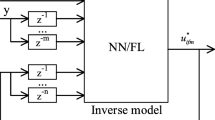Abstract
This paper proposes a new cascade training multilayer fuzzy logic for identifying forward model of multiple-inputs multiple-outputs (MIMO) nonlinear double-coupled fluid tank system based on experiment platform. The novel multilayer fuzzy model consists of multiple MISO model; for each MISO model, it composes of multiple single fuzzy Takagi–Sugeno (T–S) models. The cascade training using optimization algorithms optimally trained multilayer fuzzy model one by one. All parameters of multilayer fuzzy model were optimally and comparatively identified using DE, GA and PSO optimization algorithms. Then, the proposed method results are compared with normal training method results. The experimental results show that proposed method gives better performance than the normal training. Hence, the novel proposed optimized multilayer fuzzy model is efficiently applied for identifying MISO system. The experiment cascade training is clearly presented. It proves more accurate and takes less time to compute than the normal training, and it seems promisingly scalable as a simple and efficient method to successfully identify and control various uncertain nonlinear large-scale MIMO systems.
















Similar content being viewed by others
References
Zadeh, L.A.: Fuzzy sets. Inf. Control 8(8), 338–3365 (1965)
Espinosa, J., Vandewalle, J., Wertz, V.: Fuzzy Logic, identification and predictive control. Springer, Berlin (2005)
Anh, H.P.H., Ahn, K.K.: Identification of pneumatic artificial muscle manipulators by a MGA-based nonlinear NARX fuzzy model. Mechatronics 19(1), 106–133 (2009)
Takagi, T., Sugeno, M.: Fuzzy identification of systems and its applications to modeling and control. IEEE Trans. Syst. Man Cybern. SMC-15(1), 116–132 (1985)
Mendes, J., Araújo, R., Souza, F.: Adaptive fuzzy identification and predictive control for industrial processes. Expert Syst. Appl. 40(17), 6964–6975 (2013)
Rutkowski, L., Korytkowski, M., Scherer, R., Tadeusiewicz, R., Zadeh, L.A., Zurada, J.M.: New method for fuzzy nonlinear modelling based on genetic programming. Lecture notes in computer science] artificial intelligence and soft computing, vol. 9692, no. 38, pp. 432–449 (2016)
Li, Y., Tong, S., Li, T.: Hybrid fuzzy adaptive output feedback control design for uncertain MIMO nonlinear systems with time-varying delays and input saturation. IEEE Trans. Fuzzy Syst. 24(4), 841–853 (2016)
Bagis, A., Konar, M.: Comparison of Sugeno and Mamdani fuzzy models optimized by artificial bee colony algorithm for nonlinear system modelling. Trans. Inst. Meas. Control 38(5), 579–592 (2016)
Ferdaus, M.M. et al. Fuzzy clustering based nonlinear system identification and controller development of Pixhawk based quadcopter. In: Advanced Computational Intelligence (ICACI), 2017 Ninth International Conference on. IEEE, pp. 223–230 (2017)
Tavoosi, J., Suratgar, A.A., Menhaj, M.B.: Nonlinear system identification based on a self-organizing type-2 fuzzy RBFN. Eng. Appl. Artif. Intell. 54, 26–38 (2016)
Aleksovski, D., Kocijan, J., Džeroski, S.: Ensembles of fuzzy linear model trees for the identification of multi-output systems. IEEE Trans. Fuzzy Syst. 24(4), 916–929 (2016)
Raju, G., Zhou, J., Kisner, R.: Hierarchical fuzzy control. Int. J. Control 54(5), 1201–1216 (1991)
Sun, L., Huo, W. Adaptive fuzzy control of spacecraft proximity operations using hierarchical fuzzy systems. In: IEEE/ASME Transactions on Mechatronics, vol. 4435, no. c, pp. 1–1 (2015)
Rodríguez, F.O., de Jesús Rubio, J., Gaspar, C.R.M., Tovar, J.C., Armendáriz, M.A.M.: Hierarchical fuzzy CMAC control for nonlinear systems. Neural Comput. Appl. 23(S1), 323–331 (2013)
Tu, K.Y., Lee, T.T., Wang, W.J.: Design of a multi-layer fuzzy logic controller for multi-input multi-output systems. Fuzzy Sets Syst. 111(2), 199–214 (2000)
Li, H., Wu, C., Yin, S., Lam, H.K.: Observer-based fuzzy control for nonlinear networked systems under unmeasurable premise variables. IEEE Trans. Fuzzy Syst. 24(5), 1233–1245 (2016)
Al-Hmouz, R., Pedrycz, W., Balamash, A., Morfeq, A.: Hierarchical system modeling. IEEE Trans. Fuzzy Syst. PP(99), 1–1 (2017)
Cervantes, L., Castillo, O., Soria, J.: Hierarchical aggregation of multiple fuzzy controllers for global complex control problems. Appl. Soft Comput. 38, 851–859 (2016)
Gotmare, A., Bhattacharjee, S.S., Patidar, R., George, N.V.: Swarm and evolutionary computing algorithms for system identification and filter design: a comprehensive review. Swarm Evol. Comput. 32, 68–84 (2017)
Rastegar, S., Araújo, R., Mendes, J.: Online identification of Takagi–Sugeno fuzzy models based on self-adaptive hierarchical particle swarm optimization algorithm. Appl. Math. Model. 45, 606–620 (2017)
Loussifi, H., Nouri, K., Braiek, N.B.: A new efficient hybrid intelligent method for nonlinear dynamical systems identification: the Wavelet Kernel Fuzzy Neural Network. Commun. Nonlinear Sci. Numer. Simul. 32, 10–30 (2016)
Konar, M., Bagis, A.: Performance comparison of particle swarm optimization, differential evolution and artificial bee colony algorithms for fuzzy modeling of nonlinear systems. Elektronika ir Elektrotechnika 22(5), 8–13 (2016)
Kien, C.V., Son, N.N., Anh, H.P.H.: Identification of 2-DOF pneumatic artificial muscle system with multilayer fuzzy logic and differential evolution algorithm. In: The 12th IEEE Conference on Industrial Electronics and Applications (ICIEA 2017), June 18–20, Siem Reap, Cambodia, pp. 1261–1266
Tong, S., Sun, K., Sui, S.: Observer-based adaptive fuzzy decentralized optimal control design for strict feedback nonlinear large-scale systems. IEEE Trans. Fuzzy Syst. (2017). https://doi.org/10.1109/TFUZZ.2017.2686373,PP(99)
Storn, R., Price, K.: Differential evolution—a simple and efficient heuristic for global optimization over continuous spaces. J. Glob. Optim. 11(4), 341–359 (1997)
Acknowledgements
This research is fully funded by Viet Nam National Foundation for Science and Technology Development (NAFOSTED) under Grant Number 107.01-2015.23, Viet Nam.
Author information
Authors and Affiliations
Corresponding author
Rights and permissions
About this article
Cite this article
Van Kien, C., Anh, H.P.H. & Nam, N.T. Cascade Training Multilayer Fuzzy Model for Nonlinear Uncertain System Identification Optimized by Differential Evolution Algorithm. Int. J. Fuzzy Syst. 20, 1671–1684 (2018). https://doi.org/10.1007/s40815-017-0431-x
Received:
Revised:
Accepted:
Published:
Issue Date:
DOI: https://doi.org/10.1007/s40815-017-0431-x




